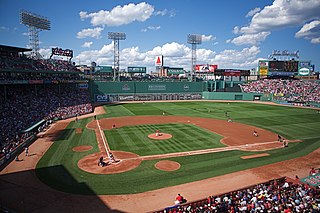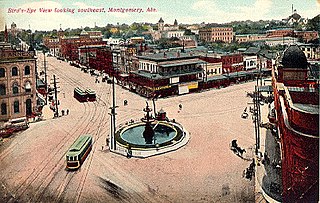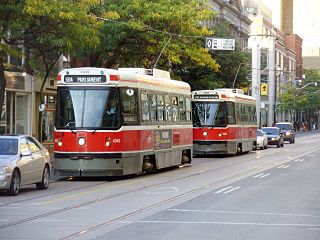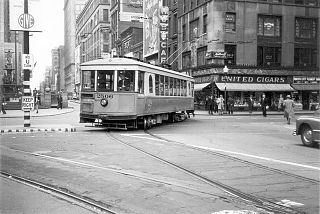

The Richmond Union Passenger Railway, in Richmond, Virginia, was the first practical electric trolley (tram) system, and set the pattern for most subsequent electric trolley systems around the world. It is an IEEE milestone in engineering. [1]

Richmond is the capital of the Commonwealth of Virginia in the United States. It is the center of the Richmond Metropolitan Statistical Area (MSA) and the Greater Richmond Region. Richmond was incorporated in 1742 and has been an independent city since 1871.

A tram is a rail vehicle which runs on tramway tracks along public urban streets; some include segments of segregated right-of-way. The lines or networks operated by tramcars are called tramways. Historically the term electric street railways was also used in the United States. In the United States, the term tram has sometimes been used for rubber-tyred trackless trains, which are not related to the other vehicles covered in this article.

The Institute of Electrical and Electronics Engineers (IEEE) is a professional association with its corporate office in New York City and its operations center in Piscataway, New Jersey. It was formed in 1963 from the amalgamation of the American Institute of Electrical Engineers and the Institute of Radio Engineers.
Contents
The Richmond system was not the first attempt to operate an electric trolley. According to the IEEE, there were at least 74 earlier attempts to provide electric trolley service in over 60 communities in North America, the United Kingdom, and continental Europe. However, these earlier attempts were not reliable enough to replace the existing animal-hauled street railways.

North America is a continent entirely within the Northern Hemisphere and almost all within the Western Hemisphere; it is also considered by some to be a northern subcontinent of the Americas. It is bordered to the north by the Arctic Ocean, to the east by the Atlantic Ocean, to the west and south by the Pacific Ocean, and to the southeast by South America and the Caribbean Sea.

The United Kingdom, officially the United Kingdom of Great Britain and Northern Ireland but more commonly known as the UK or Britain, is a sovereign country lying off the north-western coast of the European mainland. The United Kingdom includes the island of Great Britain, the north-eastern part of the island of Ireland and many smaller islands. Northern Ireland is the only part of the United Kingdom that shares a land border with another sovereign state—the Republic of Ireland. Apart from this land border, the United Kingdom is surrounded by the Atlantic Ocean, with the North Sea to the east, the English Channel to the south and the Celtic Sea to the south-west, giving it the 12th-longest coastline in the world. The Irish Sea lies between Great Britain and Ireland. With an area of 242,500 square kilometres (93,600 sq mi), the United Kingdom is the 78th-largest sovereign state in the world. It is also the 22nd-most populous country, with an estimated 66.0 million inhabitants in 2017.

Europe is a continent located entirely in the Northern Hemisphere and mostly in the Eastern Hemisphere. It is bordered by the Arctic Ocean to the north, the Atlantic Ocean to the west and the Mediterranean Sea to the south. It comprises the westernmost part of Eurasia.
The Richmond system was designed by Frank Julian Sprague. After trials in late 1887, it began regular operation on February 2, 1888, with 10 streetcars. Electric power was supplied through overhead trolley wires (450 volts) for two 7.5 horsepower (5.6 kW) motors on each car. Large cars weighed 6,900 pounds (3,100 kg), provided 40 seats, and carried up to 100 passengers; small cars weighed 6,700 pounds (3,000 kg) with 22 seats and up to 65 passengers. Running speed was 7.5 miles per hour (12.1 km/h), with 15 miles per hour (24 km/h) as a maximum speed. By June 1888 the system contained 40 cars running on some 12 miles (19 km) of track, including steep grades, and with 30 degree or 193.18-foot (58.88 m) minimum radius curves.

The volt is the derived unit for electric potential, electric potential difference (voltage), and electromotive force. It is named after the Italian physicist Alessandro Volta (1745–1827).

The grade of a physical feature, landform or constructed line refers to the tangent of the angle of that surface to the horizontal. It is a special case of the slope, where zero indicates horizontality. A larger number indicates higher or steeper degree of "tilt". Often slope is calculated as a ratio of "rise" to "run", or as a fraction in which run is the horizontal distance and rise is the vertical distance.
Degree of curve or degree of curvature is a measure of curvature of a circular arc used in civil engineering for its easy use in layout surveying.
Its success proved that electric traction was both safe and reliable. The Boston City Council, after inspecting Richmond's system on September 7, 1888, approved construction the second such project by the West End Street Railway. Boston's trolley was closely patterned upon Richmond's, and again demonstrated its practicality. By 1895 almost 900 electric street railways and nearly 11,000 miles (18,000 km) of track had been built in the United States, and in a little over a decade animal-powered street railways had essentially vanished.

Boston is the capital and most populous city of the Commonwealth of Massachusetts in the United States. The city proper covers 48 square miles (124 km2) with an estimated population of 685,094 in 2017, making it also the most populous city in New England. Boston is the seat of Suffolk County as well, although the county government was disbanded on July 1, 1999. The city is the economic and cultural anchor of a substantially larger metropolitan area known as Greater Boston, a metropolitan statistical area (MSA) home to a census-estimated 4.8 million people in 2016 and ranking as the tenth-largest such area in the country. As a combined statistical area (CSA), this wider commuting region is home to some 8.2 million people, making it the sixth-largest in the United States.
Richmond's electric trolley service ended on November 25, 1949. [1]


















